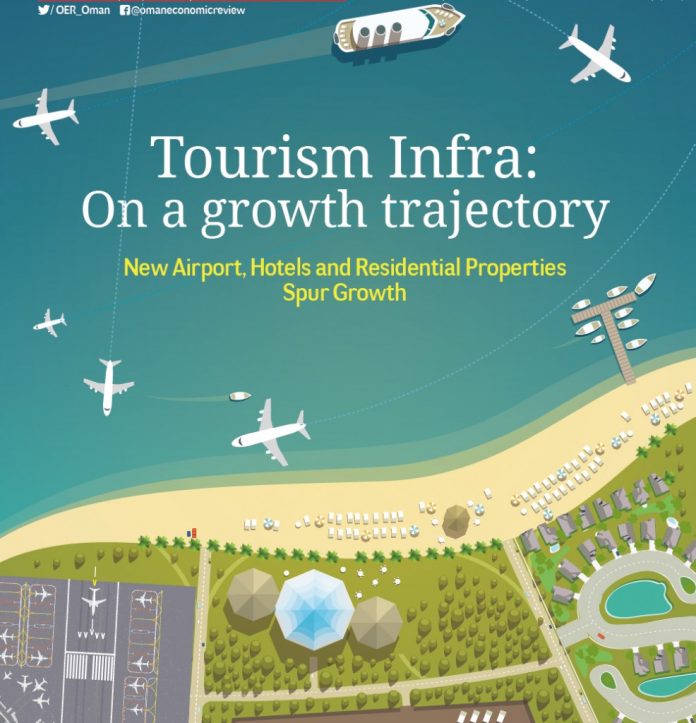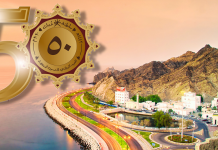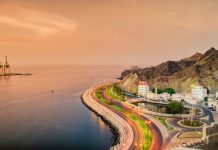Oman’s tourism sector is getting a facelift with significant investment in hospitality infrastructure, prudent policy measures and effective international campaigns, in line with government’s 2040 strategy. Muhammed Nafie reports
A country of breathtaking natural beauty interwoven with a kaleidoscope of history, legends and adventures, the Sultanate of Oman has tourism destinations that suit the taste of different categories of tourists and visitors. At a time when the country is bracing itself for a post-oil future, pursuing its diversification drives with a renewed sense of urgency, the government is making tourism a central plank of its economic strategy, with mega plans to enhance its appeal among tourists from across the globe with a series of initiatives such as better air connectivity, airport facility, hotels and resorts, and e-visa facility. The whole idea is to help the country mature from being an ‘emerging’ tourism market into an established one with a high-volume of repeat guests and a diverse range of feeder markets.
An ambitious stride towards making tourism one of the most significant income generators in the Sultanate has been the 2040 Tourism Strategy which provides a comprehensive blueprint for tourism development in Oman and outlines a series of targets for the country’s tourism sector. The strategy unveiled by the Ministry of Tourism is a clearly defined and structured road map for future growth aimed at making tourism one of the most important economic pillars for the country’s future. The implementation of tourism strategy would avail more than 500,000 jobs by the end of 2040, with the total investment in the sector expected to touch RO19bn of which only 12 per cent will be by the public sector. The contribution of tourism sector to the GDP would range between 6 to 10 per cent.
The country is investing heavily in its tourism and hospitality infrastructure as it aims to host seven million tourists by 2040, including 2.7 million in Muscat. According to a projection by Colliers International, tourism arrivals to Oman will increase at a compound annual growth rate (CAGR) of 13 per cent between 2018 and 2021, which will be driven by visitors from across the Gulf region, which accounted for 48 per cent of guests in 2017. In addition, arrivals from India (10 per cent), Germany (6 per cent), the United Kingdom (5 per cent) and the Philippines (3 per cent) are also expected to contribute immensely to the growth, supported by easy visa procedures and improved flight connections. Historically, the Middle East has been the largest source market for Oman, with arrivals from the region growing at an annual rate of 20 per cent between 2012 and 2017. The latest data shows that the growth in visitor numbers to Oman will continue, supported by strategic investment from the government as it turns to tourism to diversify its revenue streams.
 According to the Ministry of Tourism, the Sultanate experienced a 4.7 per cent growth in the number of international visitors in 2017, testament to the efforts of the government to boost non-oil sectors as part of the Vision 2040. The Sultanate’s tourism revenue exceeded RO1.2bn in 2017, with a large share of the revenue coming from domestic tourists. Says HE Maitha Saif Al Mahrouqi, undersecretary of the Ministry of Tourism, “The tourism sector in the Sultanate is witnessing a remarkable annual growth with statistical indicators pointing out the increase in the number of tourists and visitors; as well as the launch of new tourism projects and hotel facilities around the Sultanate reinforced by the governmental efforts in further developing the vital projects and the infrastructures related to tourism, in addition to facilitating and creating tourism related initiatives. This comes as a part of the Ministry’s efforts in implementing the first phase of the tourism strategy in addition to integrating and cooperating with different sectors and institutes that are working directly or indirectly with th ministry from within the tourism sector and other sectors as well.”
According to the Ministry of Tourism, the Sultanate experienced a 4.7 per cent growth in the number of international visitors in 2017, testament to the efforts of the government to boost non-oil sectors as part of the Vision 2040. The Sultanate’s tourism revenue exceeded RO1.2bn in 2017, with a large share of the revenue coming from domestic tourists. Says HE Maitha Saif Al Mahrouqi, undersecretary of the Ministry of Tourism, “The tourism sector in the Sultanate is witnessing a remarkable annual growth with statistical indicators pointing out the increase in the number of tourists and visitors; as well as the launch of new tourism projects and hotel facilities around the Sultanate reinforced by the governmental efforts in further developing the vital projects and the infrastructures related to tourism, in addition to facilitating and creating tourism related initiatives. This comes as a part of the Ministry’s efforts in implementing the first phase of the tourism strategy in addition to integrating and cooperating with different sectors and institutes that are working directly or indirectly with th ministry from within the tourism sector and other sectors as well.”
HE Maitha adds that the ministry has always been keen to participate annually in international travel and tourism events where major organisations and investors from all around the world gather in one spot to exchange knowledge, experiences and build bridges of common interests.
A fillip to the aviation
The recent opening of Oman’s most modern Muscat International Airport is expected to further strengthen the growth of aviation sector in the country. The state-of-the-art airport has a capacity to handle 40 flights per hour with 86 check-in counters, 40 gates, and 29 aircraft stands with passenger boarding bridges, as well as a new control tower.
Out of ten carousels for bag handling, eight will be used for international flights. The decision to build a new airport was taken after studies found that there could be a 40 per cent growth in number of visitors to Oman by 2019.
 The new terminal has a capacity to handle 12 million passengers per annum, which can be scaled up to 24 million, 36 million and 48 million in different phases if needed. The new terminal will have the capacity to handle large aircraft such as the Airbus A380 and the Boeing 747. The existing terminal will be used for low-cost carrier operations. The number of passengers at Muscat International Airport exceeded 14 million in 2017, a robust growth of 17 per cent over the previous year.
The new terminal has a capacity to handle 12 million passengers per annum, which can be scaled up to 24 million, 36 million and 48 million in different phases if needed. The new terminal will have the capacity to handle large aircraft such as the Airbus A380 and the Boeing 747. The existing terminal will be used for low-cost carrier operations. The number of passengers at Muscat International Airport exceeded 14 million in 2017, a robust growth of 17 per cent over the previous year.
Similarly, Salalah International Airport also broke its record with a 24 per cent growth at 1.5 million passengers as a result of an increase in both domestic and international travel. Presently, the Muscat International Airport is ranked in the top 10 airports in the Middle East, with an average annual growth forecast of 8 per cent.
Apart from international airports in two major cities, there is a move to attract tourists to the interior regions by building airports and other infrastructure in Duqm and Sohar. Among the planned regional airports, Duqm and Sohar airports have started operations and the terminal buildings are progressing well.
A modern downtown
Oman Tourism Development Company (Omran), the executive arm of the government of Oman for the development of the tourism sector, has been entrusted with strengthening and diversifying the national economy to support Oman’s Vision 2040 through pioneering tourism infrastructure and lifestyle development across the Sultanate. Madinat Al Irfan is the Sultanate’s largest urban development project and is set to contribute to Oman Vision 2040. In the years to come, Madinat Al Irfan will have major positive national implications, contributing approximately RO400mn to the local economy.
 The eastern area (phase 1) currently being developed by Omran sits alongside Wadi Park just minutes from the newly opened Muscat International Airport. It is a multi-use district adjoining the Oman Convention & Exhibition Centre (OCEC), a world- class venue for international conferences, trade shows and concerts. Talking to OER about the current status of the phase 1, Peter Walichnowski, CEO of Omran, says: “We have different projects going on simultaneously. The first project is the Oman Convection and Exhibition Centre (OCEC), which is currently 90 per cent finished. The construction of OCEC will be finished 100 per cent by the end of 2018. This will allow us to fully open up to the international MICE market. We completed Crowne Plaza Hotel in 2017 and this year we will complete the Marriott Hotel which will support the exhibition centre. We have recently signed a management agreement with AccorHotels to open the first ibis Styles in Oman.”
The eastern area (phase 1) currently being developed by Omran sits alongside Wadi Park just minutes from the newly opened Muscat International Airport. It is a multi-use district adjoining the Oman Convention & Exhibition Centre (OCEC), a world- class venue for international conferences, trade shows and concerts. Talking to OER about the current status of the phase 1, Peter Walichnowski, CEO of Omran, says: “We have different projects going on simultaneously. The first project is the Oman Convection and Exhibition Centre (OCEC), which is currently 90 per cent finished. The construction of OCEC will be finished 100 per cent by the end of 2018. This will allow us to fully open up to the international MICE market. We completed Crowne Plaza Hotel in 2017 and this year we will complete the Marriott Hotel which will support the exhibition centre. We have recently signed a management agreement with AccorHotels to open the first ibis Styles in Oman.”
He adds,“From a construction point of view, we have finished 50 per cent of the phase 1. And the first building in our business park, the headquarters of Omantel, is under construction. We are also talking to other companies to have their headquarters here. And we hope the business park will begin to fill up over the next couple of years. We also have some pockets of residential, mix-use developments in between. We are talking to Omani developers and investors to participate in this as partners.”
Recently, Omran and Majid Al Futtaim announced a strategic partnership to develop the western area (phase 2) of Madinat Al Irfan. The joint venture will see the development of a vibrant mixed-use community that will serve as the new urban centre for Muscat. This new partnership plays a major role in Oman national economic diversification agenda and reflects Omran’s strategic role as a catalyst of investment that forges solid partnerships with trusted developers like Majid Al Futtaim to create sustainable urban destinations and significant socio-economic benefits to the Sultanate.
The new mixed-use community is located at the western area of Madinat Al Irfan and spans over 4.5 million sqm. The joint venture project investment value is estimated at RO5bn over a period of 20 years and is anticipated to create more than 30,000 direct and indirect jobs in the country. Centrally located in Muscat’s urban corridor, the development will become the gateway to Oman; creating a modern downtown for residents, businesses and visitors.
“Our partnership with Majid Al Futtaim is a clear demonstration of how Omran’s public-private strategic partnership approach is successfully bringing together the highest standards of expertise and quality with local knowledge and passion, which is now resulting in the rapid development of the local tourism industry and economy as a whole,” says Walichnowski. “We are already seeing this positive impact at Madinat Al Irfan, with the Oman Exhibition and Conference Centre precinct, which is now making a vital contribution to Oman’s MICE sector, serving as a centerpiece for wide range of major local and international events. “Working with the Majid Al Futtaim team I have no doubt we will create a fantastic array of world-class experiences for the benefit of locals, residents and international visitors alike”.
Upon completion in three key stages, Madinat Al Irfan will feature more than 11,000 residential units comprising villas, townhouses and apartments, 100,000 sqm of retail space, 700,000 sqm of office space, as well as a number of cultural and lifestyle offerings. The development will serve as an integrated, sustainable and inclusive community, true to the values of Omani society. It will cater to all segments of the local community, providing a model for future urban developments, not just locally, but across the region .It will create a new urban lifestyle not yet seen in the Sultanate.
Promoting Oman as a MICE destination
With the opening of one of the largest convention centres in the region, the government is also strengthening the country’s position as a leading MICE (meetings, incentives, conferences and exhibitions) destination.
 He adds, “Conference attendees are high on the list of visitors that Oman wishes to attract as typically, they bring 2-3 times more economic value to a country than leisure travellers and they leave with a positive impression often resulting in return visits with their families, colleagues or friends.”
He adds, “Conference attendees are high on the list of visitors that Oman wishes to attract as typically, they bring 2-3 times more economic value to a country than leisure travellers and they leave with a positive impression often resulting in return visits with their families, colleagues or friends.”
International conferences and exhibitions also bring the opportunity to showcase Oman to the world and lead to knowledge transfer and exchange, future investment potential, creation of business to business opportunities, job creation and SME development.
The rising number of internationally accredited hotels and beachside resorts is also testament to the sector’s growing success. A number of major chains have recently announced new hotels in Oman, driving the 12 per cent compounded annual rate of growth (CARG) over the next three years – from 10,924 rooms in 2017 to 16,866 in 2021. Hotel supply in Muscat more than tripled from approximately 2,900 to 9,600 rooms between 2005 and 2016. This pace of expansion is also expected to be maintained moving forward, with almost 3,400 rooms currently under construction and expected to be operational by 2018, with a further 9,000 new rooms to open by 2021, depending on the pace of planned and on-hold projects.
OCEC offers 1,100 hotel rooms while the addition of new hotels – including the Anantara in Salalah and Jebel Akhdar-is expected to add significantly to the Sultanate’s room inventory by 2020.
Other planned hotels include Muscat’s first Novotel; and the 304-room JW Marriott, all located near the Oman Exhibition & Convention Centre. Further, Starwood is developing a five-star W Hotel, as part of ongoing work at Muscat’s Royal Opera House.
Besides, leading tourism infrastructure developer, Oman Hotels and Tourism, has committed to build 10 hotels across the country by 2021.
Transforming Salalah
 Muriya is adding an additional 175 hotel rooms in Hawana Salalah by the end of 2018. The company has already opened almost 1, 000 hotel rooms between its Hawana Salalah and Jebel Sifah (Muscat) destinations. Through its partnership with the Ministry of Tourism, Muriya is transforming Salalah into a year-round tourism destination. Says CEO, Ahmed Dabbous “Tourism in Salalah during winter was rather small and limited. Through our fruitful relations with international tour operators, Muriya has helped attract direct as well as indirect flights from Europe, where in the coming season we will have an increase to nine weekly flights coming from European countries, primarily Germany, Italy, Poland, Slovakia, France and Russia. That didn’t exist five years ago, and we are continually exerting efforts to introduce Salalah as a tourism destination to new European markets, as seen with new French and Russian tourism in 2018.”
Muriya is adding an additional 175 hotel rooms in Hawana Salalah by the end of 2018. The company has already opened almost 1, 000 hotel rooms between its Hawana Salalah and Jebel Sifah (Muscat) destinations. Through its partnership with the Ministry of Tourism, Muriya is transforming Salalah into a year-round tourism destination. Says CEO, Ahmed Dabbous “Tourism in Salalah during winter was rather small and limited. Through our fruitful relations with international tour operators, Muriya has helped attract direct as well as indirect flights from Europe, where in the coming season we will have an increase to nine weekly flights coming from European countries, primarily Germany, Italy, Poland, Slovakia, France and Russia. That didn’t exist five years ago, and we are continually exerting efforts to introduce Salalah as a tourism destination to new European markets, as seen with new French and Russian tourism in 2018.”
Mina Qaboos Waterfront
Complementing its hotel pipeline, the Sultanate has made significant investments in other tourism infrastructure facilities. In yet another major initiative, Mina Qaboos Waterfront project planned in Muscat port will usher in a new concept in port developments in the Sultanate. The new port concept is a kind of waterfront port catering to cruise ships, as well as investments in hotels, restaurants, cafes and so on. Omran and Dubai-based DAMAC International, inked a landmark agreement to redevelop Muscat Port into a world-class mix use waterfront destination. The capital expenditure of the project is estimated at $1 billion. The old commercial harbour is proposed to be transformed into an integrated tourist port and lifestyle destination that includes hotels, residences, as well as a dining, retail, leisure and community facilities designed to position Muscat as a top waterfront destination in the governorate. The proposed Mina Sultan Qaboos Waterfront project will include berths for cruise ships, a marina for super yachts and leisure ports, 4 and 5-star marina hotels, hotel-operated branded residential apartments, waterside restaurants, cafes and boutiques, conference and banquet facilities, entertainment and cultural facilities, fisherman’s wharf, and historic souq. The government is planning similar developments in two other locations – Khasab and Shinas.
Khasab features a modest-size port that already attracts growing numbers of cruise ships. Shinas, on the other hand, has a jetty that primarily caters to fishing boats and dhows.
Upgrading the system
Oman relied a lot on domestic tourism recently but this is changing as we see more and more international travellers visiting the Sultanate. An exquisite blend of history and modernity, of cultural heritage and urban infrastructure and of natural beauty and best-in-class services is what makes today’s Oman a tourism destination of choice for international travellers.

However, although Oman has one of the most diverse environments in the Gulf region with various tourist attractions and is particularly well known for cultural tourism, the Sultanate must adapt to a constantly changing world. Says David Faull, general manager of the newly opened Sundus Rotana Muscat, “When it comes to our tourism and hospitality sector there are many things like visa restrictions, direct flights, Omanisation rates, infrastructure that are considered the key challenges facing the growth. Oman’s Ministry of Tourism has identified these and other important challenges and are working hard hand in hand with all of us to develop further the tourism sector.” He adds, “The new Muscat International Airport, Oman Convention & Exhibition centre are one of the biggest boosts for the tourism sectors. The opening of the airport allowed the airlines to open more flight destinations which means more guests to us and more visitors to Oman while the opening of Oman Convention & Exhibition Centre has a sizeable impact on Oman’s economy and the MICE segment in particular. The relaxation of visa requirements is encouraging longer stays, and visits to multiple regions and attractions. Other developments under construction across Oman include adventure destinations and parks and entertainment centres.”
In short, major upgrades and projects are definitely the way to go and Oman is working on the tools needed to fulfil the future goals to boost tourism growth.






